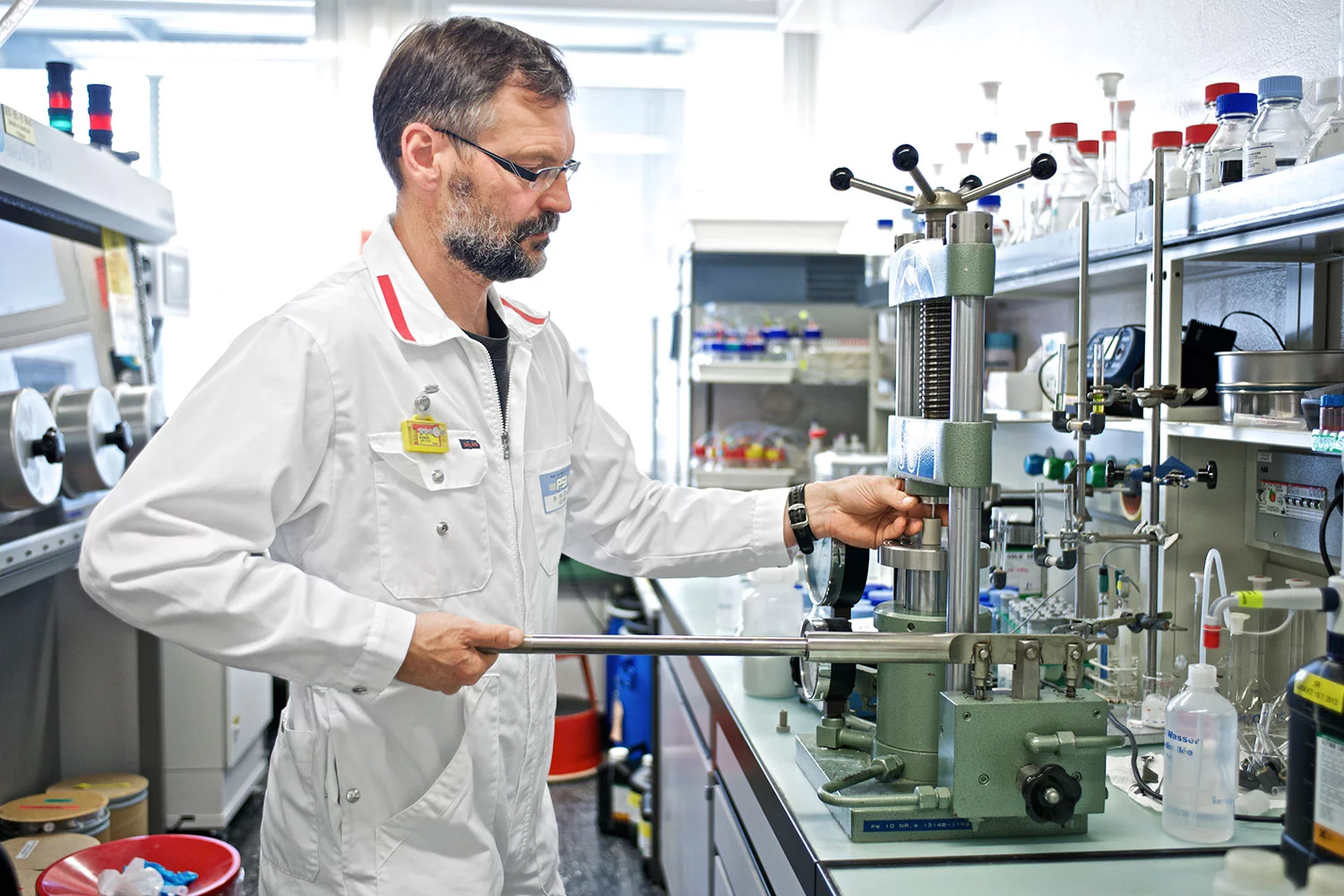How do radioactive substances move through the host rock in a deep repository for nuclear waste? Researchers from the Diffusion Processes Group in the Laboratory of Waste Management at the Paul Scherrer Institute (PSI) have been investigating. The transport properties of negatively charged radionuclides, which are repelled by the negatively charged surfaces of clay minerals and thus hardly adhere to the rock, are well known. An EU project in which the PSI is also involved is now yielding similar insights into positively charged and therefore highly adherent radionuclides.
In selecting the site for their deep nuclear waste repositories, Switzerland like other countries (e.g.: France, Belgium, Hungary, Canada) is turning to clay rock. Clay formations such as Opalinus Clay mostly occur in the form of massive blocks and exhibit a layered, compact structure with typically narrow pores, which makes it difficult for radioactive atoms (radionuclides) to penetrate and head towards the Earth’s surface. Moreover, the surfaces of the clay minerals are negatively charged, which means that positively charged radionuclides adhere to them through electrostatic forces or chemical bonds. In other words, clay rock effectively forms a trap for these radionuclides. Furthermore, due to the small dimensions of the pores, the water in the clay rock is barely able to move, if at all, which means that it is impossible for the radionuclides to wash away. Consequently, only one option remains for them to escape from the host rock: diffusion.
Thermally driven escape route
The term diffusion refers to the process of the random, undirected movement of particles in a medium, which results in the more or less uniform spatial distribution of these particles which were originally concentrated in one place. Diffusion is caused by thermal vibration, which affects all atoms or molecules. Therefore, diffusion depends on temperature.
The research conducted by the Diffusion Processes Group at the PSI’s Laboratory of Waste Management concerns the diffusion of radionuclides through the host rock of a deep repository. The team of scientists headed by Luc Robert Van Loon has spent many years researching mechanisms and properties of radionuclide diffusion in all candidate rock types considered for a Swiss deep repository. The results help the National Cooperative for the Disposal of Radioactive Waste (NAGRA) to evaluate the deep repository sites proposed in Switzerland based on strict scientific criteria. The diffusion of negatively charged and neutral radionuclides, especially in Opalinus Clay, has been very well documented in recent decades. Under the EU project CatClay, the researchers have now been gaining key insights into moderately to highly sorbent (positively charged) radionuclides since 2010.
Sticking doesn’t necessarily mean staying put
Positively charged radionuclides adhere to the boundary layer in the clay rock, which makes their diffusion more complex. After all, sticking to the surfaces does not mean that the radionuclides remain there in one place. Instead, they are able to move along the surface without losing contact with it. Quantifying and understanding this so-called surface diffusion is one of the aims of the CatClay project. In concrete terms, the researchers now want to study the diffusion of different radionuclides in the mineral illite, one of the most common components of clay rock that, like many other clay minerals, swells heavily during water uptake. As radionuclides are squeezed into the rock sample in an aqueous solution in the diffusion experiments, the diffusion cell around the sample needs filters that let this solution through but at the same time hold the rock together and prevent it from crumbling.
Because conventional porous steel filters are not well suited for this task, the scientists have opted to use thin plastic membranes instead. Through this choice they circumvent the problem of some of the positively charged radionuclides remaining stuck in the porous steel. A measurement would be impossible under such conditions as the radionuclides would find it difficult to diffuse into the rock sample. The PSI researchers designed their new diffusion cell in such a way that the mechanical stability of the polymer membranes is guaranteed, while at the same time, allowing a high enough diffusive flow of radionuclides.
Good omen for the new diffusion cell
So far, the PSI researchers have been measuring the diffusion coefficients (the measure of the speed of diffusion) of the twice positively charged isotopes Co-60 and Zn-65. Both are relatively adherent radionuclides and the researchers have found strong indications that surface diffusion actually does play a role for them. This insight will help better describe in theoretical models the diffusion of these and similar radionuclides . The other good news is the fact that the new diffusion cell has done its job reliably so far. However, Van Loon points out that the acid test for the instrument will be further measurements. Whether it will pass this acid test remains to be seen, but the scientists hope it will. After all, lab measurements are indispensable for the research into deep storage for radioactive substances. As Van Loon explains, many more radionuclides can be studied in a short period of time and under controlled conditions in the lab than in field measurements such as those NAGRA is conducting in the Mont Terri field lab. Even if the field lab experiments are necessary in the end, without the groundwork in the lab the progress made in gaining insights into this enormously important field would be much slower.
Text: Leonid Leiva
Additional information
Labarotarory for Waste ManagementContact
Dr. Luc Robert Van Loon, Head of the Difussion Processes Group, Laboratory for Waste Management,Paul Scherrer Institute,
Telefon: +41 56 310 22 57, E-Mail: luc.vanloon@psi.ch

